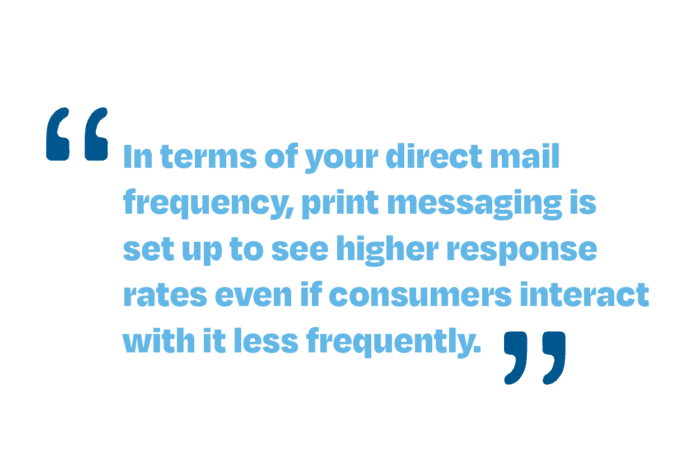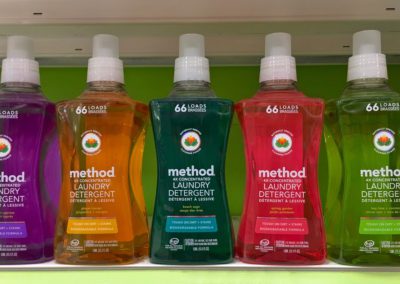How often should you send direct mail? Is there a special cadence to direct mail frequency? Better yet, what are some of the direct mail frequency best practices? How often should newsletters be sent to get the most out of your campaign?

If you’re interested in starting a direct mail marketing campaign, you are at the right place.
With over a decade of experience producing high-quality direct mail content for businesses across various industries, we know what works (and what doesn’t). We’re so adamant about maintaining consistency with your print marketing campaigns because when it comes to direct mail, consistency matters — a lot.
If you’re not staying in regular contact with your audience through a print campaign, you are doing your business a huge disservice.
It makes sense if you think about it. We’ve all lost touch with friends, family members, or colleagues due to a lack of consistent contact. Or perhaps you have had the dreaded experience of going on a date with someone you really liked, only to have them not reach out for weeks or even months at a time. That lack of demonstrated interest is a recipe for one thing: distance.
Face it — relationships with businesses can be even flimsier. In fact, it’s shockingly easy to lose a customer. Seventy-six percent of consumers say they stop doing business with a company after one poor experience, and many forget about brands they don’t interact with frequently. So, what does that mean for your business’s direct mail frequency?
Let’s start with a simple question: How frequent is too frequent?
How Often Should You Send Direct Mail?
You’ve probably heard about the dangers of over-posting or over-emailing when sharing your business’s promotional materials. It’s true! In our digital age, bombarding your audience with constant branded digital noise is one of the worst things you can do for your engagement levels. So, what’s different about direct mail?
Regarding direct mail consistency, it is difficult to mail too often. Print marketing requires planning, designing, printing, and shipping. That process takes significantly longer than putting an idea together for a digital advertisement and sending it within the same day — or even an hour. That doesn’t mean it’s impossible to set your direct mail frequency too high (please see your local cable company for an excellent example of over-mailing). Still, it would be pretty tricky to do by accident.
Contrastingly, a minimum level is required to obtain an optimal direct mail cadence.
The American Marketing Association recommends a cycle of sending direct mail every 21 days for the best results. That’s because consistency is critical in running a successful print marketing campaign.
Research has shown customers may need to hear from you as many as 11 times before they are ready to buy, with response rates increasing substantially after the third mailing.

But why do consumers seem more willing to accept print marketing materials than digital ones?
What Sets Print Apart?
There are some critical differences between the way direct mail is perceived, recalled, and responded to when compared with digital communications. The following direct mail analytics can better inform us of how direct mail frequency should be treated and why the same concerns associated with digital advertising do not apply.
Consumer Perception
How consumers perceive print differs significantly from how they receive digital communication.
- Digital communications can feel cheap, repetitive, and intrusive due to over-saturation (we see about 4,000–10,000 of them every day). By contrast, print is much less common.
- 3 out of every 4 customers report feeling special after receiving branded direct mail materials.
- Even more telling is that 8 out of every 10 consumers enjoy receiving branded direct mail materials and look forward to it. How many emails do you receive a day that you actually look forward to?
- Print is also seen as more trustworthy and, in many cases, preferable to digital communication. Seventy-three percent of people prefer print advertisements over digital ads, and print is still the most trusted form of company-sponsored advertising, according to 82% of consumers.

In other words, over-communicating is much less of a concern when it comes to your direct mail frequency than with other marketing channels.
Information Recall
Consumers also spend more time with print advertisements and have better recall of the material. That means you do not have to match the frequency of digital marketing to get the same (or better) results.
Readers typically spend less than 5 minutes on digital news sites. In contrast, readers spend an average of 20 minutes or more engaging with print publications. So, even if you only send out print content every 21 days, there is still a good chance your readers will spend a long time interacting with it.

This may be due (at least in part) to the fact that the majority of consumers report feeling that print materials are easier to read and digest than digital ones. In fact, 92% of consumers between 18 and 23 report that print is easier to read than digital.
That extended time results in significantly higher recall of the material, with the details of branded print materials being recalled 77% of the time (compared to 46% for digital). Additionally, 8 of every 10 consumers forget information learned from most marketing content after 3 days, with half forgetting it altogether. With that in mind, maintaining a consistent print mail cadence is essential to a campaign’s success.
Response Rates
Print marketing has astoundingly high response rates (9%) compared with digital marketing channels (1% or less). This discrepancy can likely be attributed to people spending more time engaging with print materials than digital. That, combined with how consumers already have a higher perception of print materials, creates a recipe for high response rates.
This also directly impacts sales and buying habits. Nearly 8 in 10 consumers also report that they buy based on print advertisements, compared to less than 5 in 10 who buy based on digital ads. That’s a game-changer if you’re trying to drive more traffic to your business. It’s also much more effective than email, with print garnering a 37% higher response rate.

So, in terms of your direct mail frequency, print messaging is set up to see higher response rates even if consumers interact with it less frequently.
But how can you ensure your mailing frequency caters to the needs of your audience in real time?
Improving The Timeliness Of Your Mailings
Your direct mail frequency isn’t the only factor that matters in the success of your campaign. You also want to ensure you are taking the time to deliver the right message to the right person at the right time, every time. But how do you do that?
Delivering The Right Message
Before beginning any print marketing campaign, you should think about your goals. Are you trying to reach new leads, increase current sales, or nurture your existing audience? Your purpose will strongly influence your messaging for the campaign.
Once you have determined what that looks like for your business, it’s time to start planning what you’ll say. This is not something you can simply haphazardly throw together. Rather, the copy and the type of print assets to the design will have to be carefully planned. Then it will need to go through editing multiple times to ensure all the information is error-free.
The right message will also stand out. People receive lots of mail every day. Suppose the mail they receive from you isn’t immediately eye-catching, visually appealing, and valuable. In that case, it risks getting thrown in the trash. That’s why it’s imperative to know your audience well and cater your messaging to lean into what provides value or intrigue to them.
Delivering To The Right Person
Unlike email marketing, direct mail allows you to be freer with whom you choose to target with your print materials. It can be based on geography, demographic information, or previous purchasing history. You can even target new audiences based on the relevance of your services to them.
Segmentation is helpful in this regard because it allows you to separate your mailing list into relevant groups. You can then target your messaging more specifically to the needs and tastes of each audience. That’s why it’s critical to always collect and update the relevant demographic information within your list. Otherwise, you risk missing out on crucial opportunities to offer individuals valuable information catered to their tastes.
Delivering At The Right Time
Like with any marketing campaign, there is seldom a precise “right” time to send your message. However, you can always benefit from feedback to improve your timing. Triggered print campaigns (where a mailing is triggered automatically by an event, change, or circumstance) can be very helpful because they allow you to base your mailing time around the relevance of your message.
Let’s say you run a dog grooming service. After reviewing some of your CRM data, you notice clients typically come in monthly. However, if they do not book an appointment for more than 3 months, it is unlikely they will return. In response to this information, you set up a campaign where clients who have not returned receive a 20% off coupon in the mail after their 3rd month of absence.
Or suppose you manage a temp agency. You instruct your marketing manager to keep track of the local listings in your area and have a triggered campaign to mail a pamphlet about your services as soon as hiring notices go live.
While there may never be a perfect time to mail, setting up triggered campaigns ensures the right audience receives the right message at the best time as possible. This makes it much more likely that the readers who receive your mailings are actively interested in buying from you.
How To Add Value Through Direct Mail
Valuable content can come in various forms and heavily depends on your audience. Valuable print marketing for a bakery will be different from print marketing for a local theater. But one form of print marketing is valuable no matter your industry — and it happens to be our specialty.
Newsletters are a great way to connect with your audience through meaningful, valuable content. This content is non-promotional and not connected too rigidly to your industry or niche. The main goal of this type of content is to entertain, educate, and provide your readers with a personal connection to your business.
But how often should newsletters be sent?
With more than a decade of experience, we have learned that the right print marketing cadence for a newsletter is monthly.
When clients don’t mail monthly, they don’t see the same return on their investment they would if they increased their frequency.
That’s because a monthly mailing schedule for a newsletter allows consumers to predict (and look forward to) receiving it. When mailings are sporadic, the newsletter begins to look like an afterthought.
Our monthly clients often comment on their newsletter’s value in terms of building customer loyalty and great word-of-mouth. They note their readers report feeling more connected to them and enjoy sharing their publications with friends and family every month. This often translates to higher retention rates, more referrals, and more reactivations for these clients.
In terms of using print for relationship marketing purposes, nothing compares to a well-written, engaging monthly newsletter.
To learn more about the benefits of adding a newsletter to your marketing strategy, fill out the form below to request your free copy of our founder’s book, The Ultimate Guide to Newsletters.






